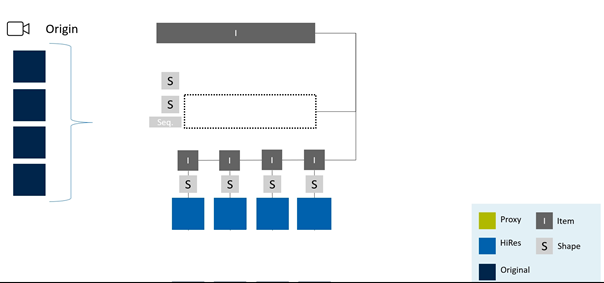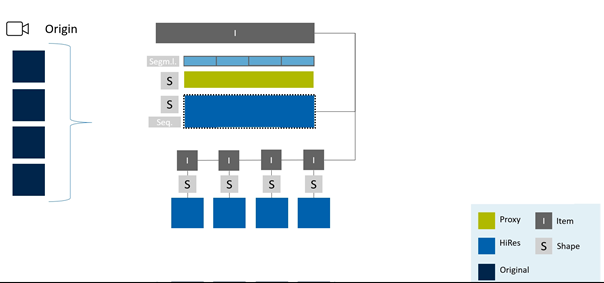Camera Material (XDCAM, P2, GoPro, etc.) [INT ENT 21.4 ARC]
For each camera card an item is created in VidiCore. Such items are marked with the metadata field V3_CameraCard (boolean) = true to be able to distinguish them from other items. The field V3_ExpectedMediaType (string) should be set to video so that the MediaPortal connector (for MediaPortal < 21.1) can identify these items as videos even if they don’t have a continuous hires shape (see below).
All original files of the disc or card are represented by an item sequence. The sequence is attached to the item describing the disc or card.

It can be rendered in VidiCore into a single physical file that will be attached to the same item as the item sequence – see Attach New File To Existing Item [INT ENT XY.Z IG] and Render Timelines [INT ENT XY.Z IG].

As both the sequence and the rendered file contain the same visible information this is consistent with VidiCore’s data model. A continuous proxy video spanning all clips is possible and can be rendered directly from the item sequence. Rendering of the continuous hires clips and the proxy video is possible in a single VidiCore transcode job.
The sequence itself refers to a list of items. These items point to the files on the disc/card and are structured as described in Types Of Item-To-Item Relations [INT ENT 21.4 ARC]. These items should be marked as hidden (V3_Hidden) to hide them in user interfaces like MediaPortal.
To have the timecodes of the original clips available even after stitching and removal of the original clips they need to be stored directly at the item that holds the stitched clip. The appropriate data structures are defined in Original Timecodes [INT ENT 21.4 ARC].
Comparing It To Worker-Based VPMS
In worker-based VPMS such material always was stitched as a StaticContainer. The concept followed the same ideas as described above.
.png)